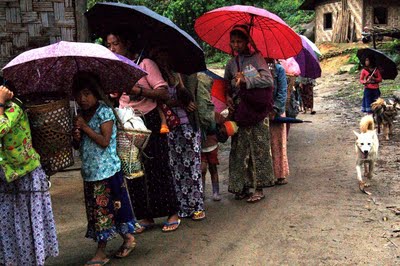Why Civil War Will Continue in Burma (Editorial)

27 June 2010: The recent breakdown of a 17 year-old ceasefire between the Burma Army and the Kachin Independence (KIO) has once again reignited renewed interests in the country’s fragile state of political stability. The Burma Army’s advances on the Kachin strongholds earlier this month was met by fierce resistance from the Kachin Independence Army (KIA) – the military wing of the KIO, which has for months readied for the imminent offensive.
The latest hostilities in northern Burma followed months of fighting in the country’s northeast and southeastern parts where the Burma Army has been launching relentless offensives against ethnic Shan and Karen resistance groups, including the Shan State Army – North (SSA-North), the Democracy Karen Buddhist Army (DKBA) and the Karean National Union (KNU). The fighting has sent tens of thousands of civilians fleeing across the border into China and Thailand.
Worrying is the pattern of the recent military offensives, where the regime seems to have been targeting some of the strongest ceasefire ethnic armies – breaking nearly 20 years of truce agreements. Burma Army’s attacks against ethnic groups have escalated since the day of Burma’s national elections on November 7 last year.
Although not surprising given the regime’s record of breaking promises, the recent attacks against the KIA has only reaffirmed the long-held view that the army-turned quasi-civil administration in Naypyidaw will not seek to embark on the path of a negotiated settlement to address the long-standing ethnic grievances against central domination.
Some 18 ethnic resistance groups have entered into some forms of ceasefire agreement with the regime over the last 20 years. But in the months leading up to the November 2010 elections, the military regime has been pressuring them to accept its Border Guard Program, where the ethnic armies are to come under the command of the Burma Army.
These ethnic armies were offered some form of joint development programs in their areas with then State Peace and Development Council (SPDC) in exchange for a temporary end to hostilities, on the promise that any political negotiation regarding their underlying grievances would be discussed with the ‘new civilian’ government.
That was never to take place. The KIO, which waited for 17 years in the hope of genuine political negotiation with SPDC-successor ‘civilian administration’, was deliberately attacked only less than three months after the new ‘civilian government’ was sworn in, in late March 2011. But it is interesting to note that the attacks weren’t accident. In fact, the KIO had been expecting offensives many months ahead.
In anticipation of imminent assaults, six ethnic armies had founded a new military alliance as early as before the 2010 November elections in Burma. The significance of this new alliance was that it include both ceasefire and non-ceasefire groups. The alliance is made up of three ceasefire groups; Kachin Independence Organization (KIO), New Mon State Party (NMSP) and Shan State Army – North (SSA-N); and non-ceasefire groups; Karen National Union (KNU), Karenni National Progressive Party (KNPP) and Chin National Front (CNF).
Recently transformed as the United Nationalities Federal Council (UNFC), the six ethnic armies have agreed to come under a NATO-style one central joint military command to coordinate a collective military response against any Burma Army’s aggression against anyone of its members.
Even with all the sophisticated weapons and modern military hardware it has acquired from China, it is unlikely the new Burmese regime can find a military solution to the decades-long conflict with the ethnic groups. Heavily outgunned and outnumbered, the ethnic armies are still confident in their ability to maintain resistance capabilities because they know the terrains of the battle grounds, that they enjoy the support of their people, and above all, that they are fighting for the right cause – defending their people from the policies of extermination.
Why would civil war continue in Burma after more than 60 years of fighting that has seen so much bloodshed and suffering?
The answer lies in the continued failure by the successive Burmese regimes to accommodate the simple demands of ethnic and cultural rights and of secular pluralism in the Union of Burma. This is best expressed by none other than Aung San, the founding father of the Burma Army and the architect of the historic Panglong Agreement, which formed the legal basis for a multi-ethnic independent Union of Burma.
“What is it that particularly agitates a national minority? A minority is discontented because it does not enjoy the right to use its native language. Permit it to use its native language and this discontentment will pass of itself. A minority is discontented because it doen’st not enjoy liberty of conscience etc. Give it these liberties and it will cease to be discontented. Thus, national equality in all forms (language, schools, etc.) is an essential element in the solution of the national problem.”
Even after more than half a century, Aung San’s prescription cannot be more valid today. Civil war will continue unless these essential elements are met in Burma. But to do so will require a fundamental change in the basic State philosophy that underpins the thinking of governance in the Union of Burma.




